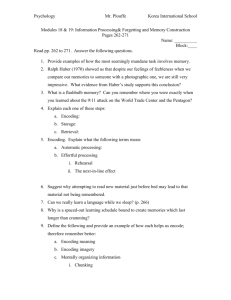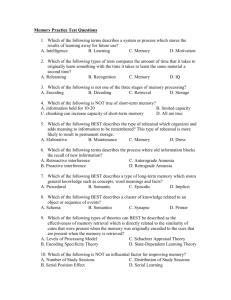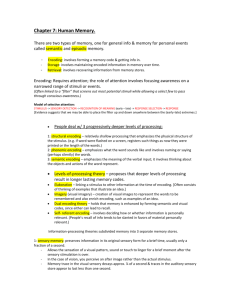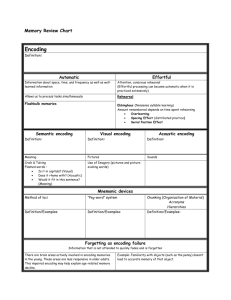Memory - Gordon State College
advertisement
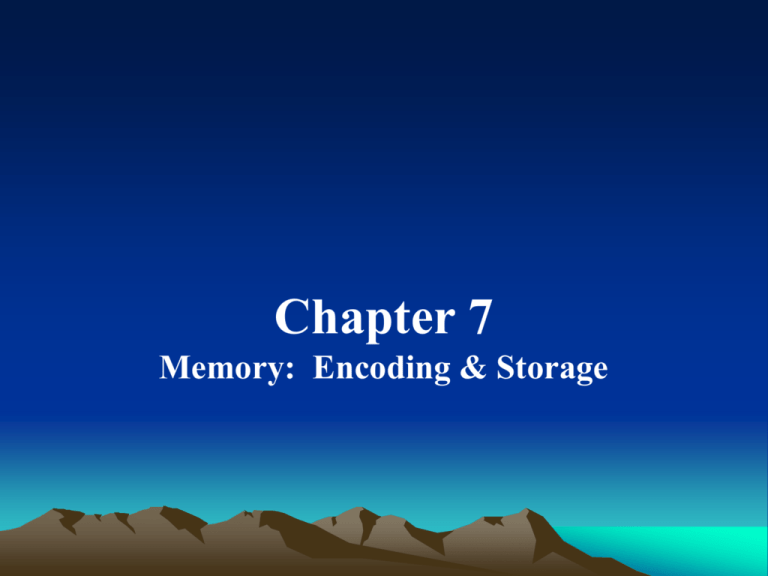
Chapter 7 Memory: Encoding & Storage The Nature of Memory • Memory: the mental process by which information is encoded and stored in the brain and later retrieved – Until the late 1950s, most psychologists viewed memory as a single system. – Due to technological advances outside the discipline and scientific discoveries within, psychologists dramatically changed their views of memory. The Computers’ Information-Processing System Has Been a Useful Model for Human Memory • According to the information-processing model of memory, there are three basic processes that information goes through: – Encoding process: incoming information is organized and transformed so it can be entered into memory – Storage process: involves entering and maintaining information in memory for a period of time – Retrieval process: involves recovering stored information from memory so it can be used Memory as Information-Processing • In the encoding process, information from our surroundings is transformed into neural language through: – Visual encoding: Information is represented in memory as a picture. – Acoustic encoding: Information is represented in memory as a sequence of sounds. – Semantic encoding: Information is represented in memory by its meaning to you. – The type of encoding used—visual, acoustic, or semantic—can influence what is remembered. The Atkinson-Schiffrin Model • Three memory systems or stages – Sensory memory: a memory system that very briefly stores the sensory characteristics of a stimulus – Short-term memory: a limited-capacity memory system where we actively “work” with information – Long-term memory: a durable memory system that has an immense capacity for information storage Overview of the InformationProcessing Model of Memory Sensory Memory – Sensory memory serves as a holding area, storing information just long enough for us to select items for attention. – Information not transferred to short-term memory is quickly replaced by incoming stimuli and lost. – Sensory memory consists of separate memory subsystems: • Iconic memory: Visual sensory memory is the fleeting memory of an image, or icon. • Echoic memory: Auditory sensory memory is often experienced like an echo. Figure 21.1 Atkinson-Shiffrin’s three-stage processing model of memory Myers: Exploring Psychology, Sixth Edition in Modules Copyright © 2005 by Worth Publishers Short-Term Memory: a “Working Memory” System • Short-term memory: the memory area where we actively “work” with information – Referred to as working memory and has three basic components: • Phonological loop: temporarily stores auditory input • Visuospatial sketchpad: temporarily stores visual and spatial images • Central executive: supervises and coordinates the other two components Short-Term Memory as Working Memory Short-Term Memory • Encoding in short-term memory is much more complex than what occurs in sensory memory encoding. – Organizing items of information into a meaningful unit, which is called “chunking,” can greatly increase the amount of information held in short-term memory. – Information is stored in short-term memory for only about 18 seconds; time can be extended through maintenance rehearsal, which is repetitively verbalizing or thinking about information. Encoding- Chunking • Organized information is more easily recalled Encoding Strategy 1: Organization • Chunking – organizing into familiar, manageable units • 1776149218121941 – use of acronyms • HOMES-Huron, Ontario, Michigan, Erie, Superior Encoding Strategy 2: Meaning Ebbinghaus – learning meaningful information requires only 1/10 the effort of learning nonsense information. Encoding Meaning Wickelgren (1977) The time you spend thinking about material you are reading and relating it to previously stored material is about the most useful thing you can do in learning any new subject matter. Encoding into Long-Term Memory • Elaborative rehearsal: rehearsal that involves thinking about how new information relates to information already stored in long-term memory; involves semantic encoding • Semantic encoding – Ignoring details and instead encoding the general underlying meaning of information Types of Encoding Encoding Effortful Automatic Encoding Strategy 3: Imagery - mental pictures - a powerful aid to effortful processing, “piggybacks” on automatic processing Mnemonics - memory aids – especially those techniques that use vivid imagery and organizational devices – Method of loci, stories, peg-words Storage What Constitutes Long-Term Memory? – In the late 1970s and early 1980s, some cognitive psychologists proposed that longterm memory consists of multiple systems that encode and store different types of information. – Memory researchers are not in agreement on how many long-term memory systems exist. Long-Term Memory Stores Different Types of Information • Explicit /Declarative • Semantic memory: more general in nature – General knowledge about the world • Episodic memory: factual information acquired at a specific time and place – Events in own life—autobiographical memories Long-Term Memory Stores Different Types of Information • Implicit/Non-Declarative • Procedural memory: retains information of how to perform skilled motor activities – Habits, activities so well-learned that we carry them out automatically. • Results of conditioning Long-Term Memories Can Be Explicit or Implicit • Explicit memory: the conscious recollection of previous experiences – Also referred to as declarative memory – Episodic and semantic memories are explicit memories. Long-Term Memories Can Be Explicit or Implicit • Implicit memory: information that influences our thoughts and actions without conscious recollection Long-Term Memory Subsystems Types of long-term memories Explicit (declarative) With conscious recall Semantic Facts-general knowledge Episodic Personally experienced events Implicit (nondeclarative) Without conscious recall Skills-motor and cognitive Dispositionsclassical and operant conditioning effects Organization of Long-term Memory Long-Term Memory Organization: Semantic Networks • Semantic network model: a theory that describes concepts in long-term memory organized in a complex network of associations – Cross-cultural studies indicate that the way people use these networks is influenced by experience and education. A Semantic Network Model Long-Term Memory Organization: Schemas • Semantic networks are less helpful in explaining how information is clustered into coherent wholes, called schemas. • People are more likely to remember things that can be incorporated into existing schemas than things that cannot. Information in Long-Term Memory Can Be Organized around Schemas • Participants given a schema in which to understand a story recalled twice as many ideas. • Further studies—schemas help us remember and organize details and speed up processing time. – Cross-cultural research indicates that cultural utility plays an important role in what kind of schemas develop and, thus, what is remembered.



